AMD Athlon 64 4000+ & FX-55: A Thorough Investigation
by Anand Lal Shimpi on October 19, 2004 1:04 AM EST- Posted in
- CPUs
Gaming
Doom 3
Our Doom 3 CPU Battlegrounds article already made it quite clear that Intel did not have what it takes to be the highest performer in Doom 3. The release of the Athlon 64 4000+ and FX-55 further extend AMD's lead in Doom 3.
Even the entry level Athlon 64 3200+ has no problems outperforming the 3.4EE
and Pentium 4 560. Doom 3 does continue to show us the ~7% performance improvement
we've been seeing thus far from going to a dual channel Socket-939 setup
over Socket-754. The added cache of the 4000+ manages to yield a 3% performance
improvement over the 3800+, definitely not worth the added premium over an
already expensive chip.
Prescott does well here (for Intel), but the Extreme Edition still takes the
cake.
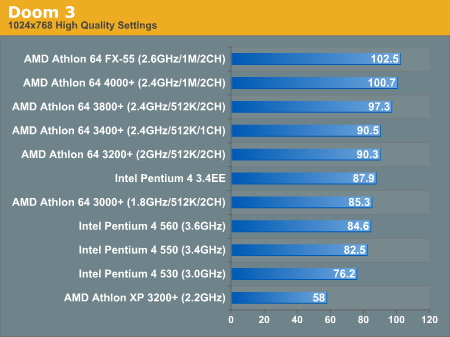
Counterstrike: Source
The next big game after Doom 3 is, of course, Half Life 2. And while the game is still not out, Valve's Visual Stress Test that comes with Counterstrike: Source gives us a good glimpse into future performance under Half Life 2.
Just like Doom 3, Half Life 2 is strictly an AMD dominated game. The Athlon 64 FX-55 outperforms the fastest Intel CPU here by a whopping 18%. Prescott performs horribly, with the Pentium 4 560 only able to outperform the Athlon XP 3200+, not even the Athlon 64 3000+.
What is extremely interesting here is the impact of memory bandwidth on the Athlon 64 platform. The impact of a dual channel memory controller is nothing short of 14%, which is almost double of what we've seen in other tests. The Athlon 64 4000+ also shows a similarly impressive performance improvement due to its larger L2 cache, putting it a full 8% faster than the 3800+.
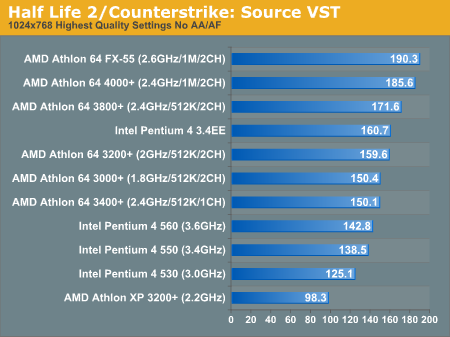
So far in gaming, AMD takes it 2 for 2.
Halo
The gaming performance dominance continues under Halo 1.05, with AMD taking the top three spots. We see much less of an impact from a larger L2 cache on the Athlon 64 platform than we did in the CS: Source VST, but dual channel is still worth close to 6% for the Athlon 64.
Prescott once again doesn't fare very well, with the 3.4EE leading the pack from Intel.
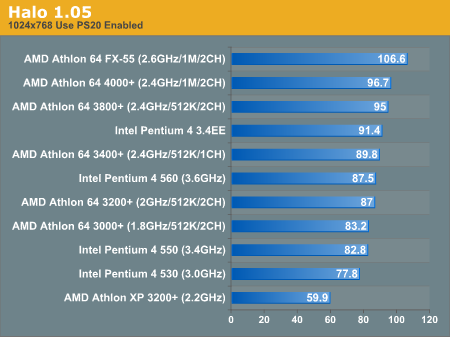
That's 3 for 3 for AMD.
Starwars Battlefront
We recently introduced Starwars Battlefront into our GPU tests last week with the release of NVIDIA's GeForce 6200. This week we're using the same test for AMD's CPU launch.
Overall we see that there's not much variance with CPU speed in Battlefront; obviously the XP 3200+'s performance is a bit dated, but the majority of the contenders here end up performing rather similarly to one another.
AMD does end up on top once again, which is not a surprise considering what we've seen in the past three tests. It would be very safe to say that AMD's Athlon 64 architecture with its on-die memory controller is very well suited for gaming performance.
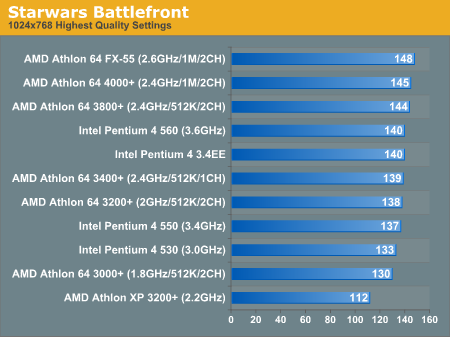
Battlefield Vietnam
Battlefield Vietnam is similar to Starwars Battlefront not only in its gameplay but also in its performance; there's no real difference between any of the top performers here. Almost all l of these CPUs end up being GPU limited at 1024x768.
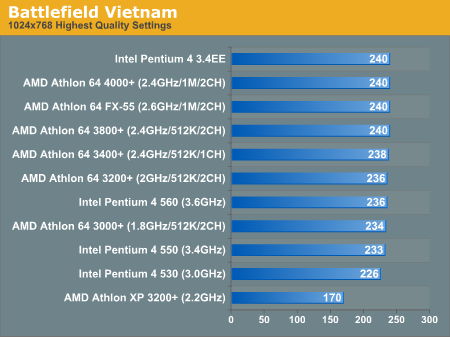
Unreal Tournament 2004
UT2004 sends AMD back to the top of the performance charts, with the top four spots once again belonging to AMD. We also find that the 4000+ improves performance by about 5% due to its larger cache, while the 3800+ continues to make a 6.7% argument in favor of Socket-939 over Socket-754.











89 Comments
View All Comments
RaistlinZ - Tuesday, October 19, 2004 - link
I may have missed it, but does anyone know if the Athlon 64 4000+ will be multiplier unlocked like the FX-53 is? That's the only thing I see that would differentiate the two chips.RaistlinZ - Tuesday, October 19, 2004 - link
Illissius - Tuesday, October 19, 2004 - link
Re: the necessity of Prescott. You are missing one very important consideration: Prescott has iAMD64 support. (Although it is currently disabled, no doubt because Intel has intentions of selling you the same processor twice). A simple die shrink of Northwood would not.I half suspect one of the reasons for Prescott's problems could be that AMD's 64-bit extensions don't mesh very well with a Netburst architecure, but they had to shoehorn it in anyways, and had to make a lot of unappealing design decisions in the process. (I've never designed a processor, though, so this is just baseless speculation.) I'd be interested in seeing 64-bit enabled chips on a Pentium M architecture...
CrystalBay - Tuesday, October 19, 2004 - link
Moores law is dead...:(Runamile - Tuesday, October 19, 2004 - link
Awsome read. Great Job. And HOLY COW does Intel get their a$$ handed to them!I would of liked to see some price/performance curves too. That would of summed it up quite nicely.
hertz9753 - Tuesday, October 19, 2004 - link
Athlon 64 3700+ 2.4GHz 1MB 64-bitAthlon 64 3400+ 2.4GHz 512KB 64-bit
Athlon 64 3400+ 2.2GHz 1MB 64-bit
araczynski - Tuesday, October 19, 2004 - link
nice, but luckily i still see no reason to upgrade my 2.4@3.3, at least not for a few measly benchmark FPS.hertz9753 - Tuesday, October 19, 2004 - link
AlphaFox - Tuesday, October 19, 2004 - link
Id like to see some kind of comparison with an OC XP Mobile. I have one runing at 2.46ghz and not really sure how it stacks up here...PrinceGaz - Tuesday, October 19, 2004 - link
An excellent article, well done.About the only thing missing was a bit of overclocking of the FX-55 to see if the introduction of strained silicon considerably increased the headroom. Obviously it has allowed them to ship parts rated at 2.6GHz which they weren't previously able to do, but how much better is the FX-55 compared to a CG-stepping FX-53? Does the use of strained silicon mean the FX-55 is a new stepping?